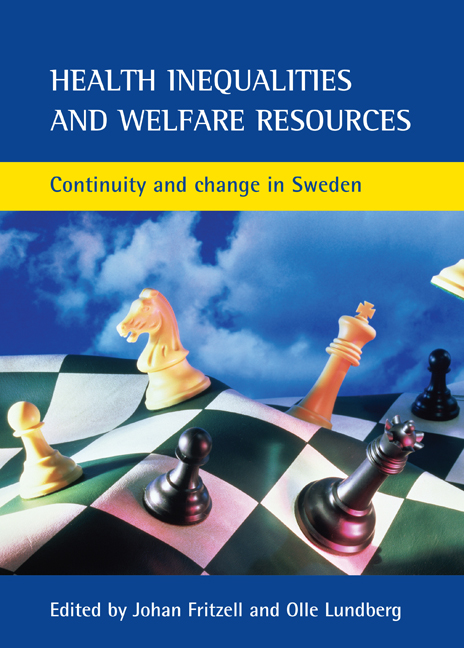Book contents
- Frontmatter
- Contents
- List of tables and figures
- Notes on contributors
- Acknowledgements
- Foreword
- one Health, inequalities, welfare and resources
- two Health and inequalities in Sweden: long and short-term perspectives
- three Changing gender differences in musculoskeletal pain and psychological distress
- four Life course inequalities: generations and social class
- five Work stress and health: is the association moderated by sense of coherence?
- six Psychosocial work environment and stress-related health complaints: an analysis of children’s and adolescents’ situation in school
- seven Assessing the contribution of relative deprivation to income differences in health
- eight Social capital and health in the Swedish welfare state
- nine ‘What’s marital status got to do with it?’: gender inequalities in economic resources, health and functional abilities among older adults
- ten Health inequalities and welfare resources: findings and forecasts
- References
- Index
- Also available from The Policy Press
five - Work stress and health: is the association moderated by sense of coherence?
Published online by Cambridge University Press: 14 January 2022
- Frontmatter
- Contents
- List of tables and figures
- Notes on contributors
- Acknowledgements
- Foreword
- one Health, inequalities, welfare and resources
- two Health and inequalities in Sweden: long and short-term perspectives
- three Changing gender differences in musculoskeletal pain and psychological distress
- four Life course inequalities: generations and social class
- five Work stress and health: is the association moderated by sense of coherence?
- six Psychosocial work environment and stress-related health complaints: an analysis of children’s and adolescents’ situation in school
- seven Assessing the contribution of relative deprivation to income differences in health
- eight Social capital and health in the Swedish welfare state
- nine ‘What’s marital status got to do with it?’: gender inequalities in economic resources, health and functional abilities among older adults
- ten Health inequalities and welfare resources: findings and forecasts
- References
- Index
- Also available from The Policy Press
Summary
Introduction
This chapter focuses on whether personality characteristics, in terms of sense of coherence (Antonovsky et al, 1990; Sagy et al, 1990), may buffer against the adverse effects of work stress exposures. To see why this research question is interesting, it is essential to recall the dramatic economic development in Sweden during the 1990s. The recession was severe with obvious consequences for the labour market, working conditions and people's lives.
Unemployment hit high levels; in 1993 8.2% of the labour force was out of work (Figure 5.1). The rising unemployment level had an impact on working conditions. Consequently, many of those still employed faced a higher risk of ill health and psychosocial problems due to aggravating circumstances at work. Physical working conditions, described as physically demanding and monotonous work, remained relatively stable during the decade. However, the risk of having a physically demanding job was higher for women (Fritzell et al, 2000b). Work intensity changed; the share of job strain (a combination of high psychological demands and low decision latitude) increased. This increase in job strain was unequally distributed in the population, with the highest increase within the public sector (le Grand et al, 2001). During the second part of the decade, the expenses for sickness absence started to rise in an uncontrollable manner that resulted in considerable costs for the welfare state (SOU, 2002, p 5). The increase was highest for long-term sickness absence, and the share of stress-related ill health escalated (Näringsdepartementet, 2000). Even if Sweden has a strong tradition of reforms and research in the field of working conditions, these important questions were not on the agenda during the times of economic depression in the early 1990s. The escalating sickness absence levels in the late 1990s brought the issue of work stress once more into focus (Tåhlin, 2001).
Two broad lines of research can be distinguished in the field of occupational stress: (1) the stress related to exposure to physical hazards at work, and (2) the stress related to exposure to psychosocial hazards. Physical hazards may be of biological, biomechanical, chemical and radiological character (Cox et al, 2000). Various physical hazards interact with one another, and with psychosocial hazards, to create effects on health (Schrijvers et al, 1998).
- Type
- Chapter
- Information
- Health Inequalities and Welfare ResourcesContinuity and Change in Sweden, pp. 87 - 108Publisher: Bristol University PressPrint publication year: 2006



